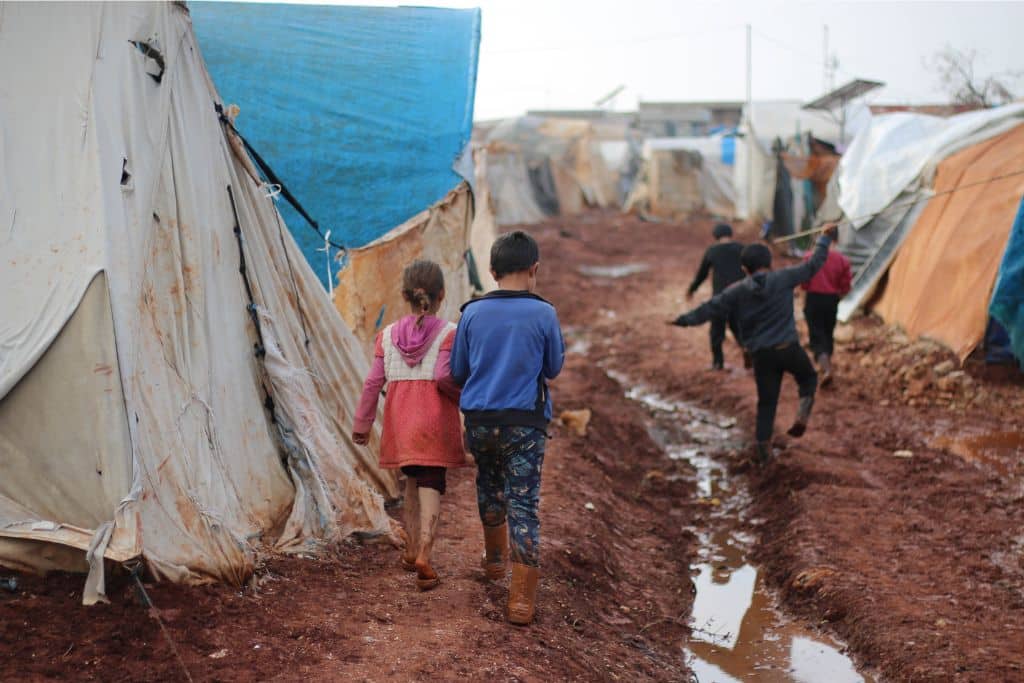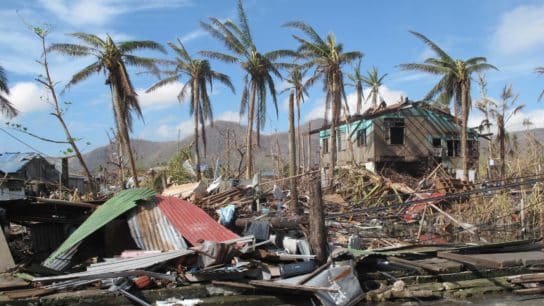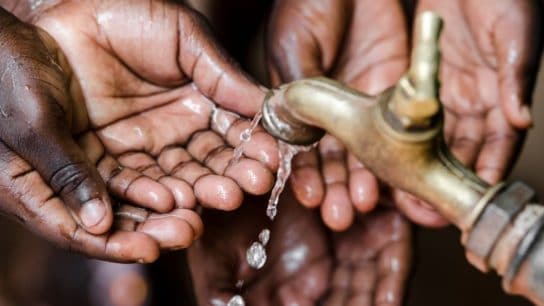As the world grapples with the escalating effects of climate change, a silent crisis is unfolding: millions of people are being uprooted from their homes, not by war or persecution, but by rising seas, devastating droughts, and extreme weather events. Climate migration is no longer a distant concern; it is a pressing reality that demands our immediate attention and action. Earth.Org explores the complexities of climate migration, its legal implications, and the urgent need for global collaboration to protect those displaced by environmental upheaval.
—
Climate migration refers to the movement of individuals or communities compelled to leave their homes because of environmental changes caused or exacerbated by climate change. These environmental changes include sudden-onset disasters, such as hurricanes, floods, and wildfires, as well as slow-onset phenomena like desertification, rising sea levels, and prolonged droughts. Unlike economic migrants, who move primarily for better opportunities or refugees fleeing persecution, climate migrants are driven by the direct and indirect impacts of environmental degradation.
The term “climate migrant” is broad and encompasses various types of movement.
Internal migration involves movement within a country’s borders due to environmental pressures, while cross-border migration refers to movement across national borders caused by climate-related factors. Temporary displacement can occur due to short-term relocation caused by sudden disasters, such as hurricanes or floods, whereas permanent resettlement happens when areas become uninhabitable due to long-term environmental changes, forcing communities to relocate permanently.
Climate Migrants vs. Refugees
It is essential to distinguish climate migrants from refugees. Refugees are defined under the 1951 Refugee Convention and its 1967 Protocol as individuals fleeing persecution based on race, religion, nationality, membership in a particular social group, or political opinion. This definition does not include those displaced by environmental factors. As a result, many individuals displaced by climate change lack formal legal status or protections. This legal gap leaves millions of people vulnerable and unprotected in the face of increasing climate-related displacement.
The drivers of climate migration are multifaceted and interconnected. Sudden-onset disasters such as hurricanes, floods, and wildfires displace millions annually. According to the International Organization for Migration (IOM), over 218 million internal displacements have occurred worldwide over the past decade due to weather-related disasters.
Slow-onset changes like desertification and rising sea levels force communities to migrate when their livelihoods become unsustainable. Resource scarcity exacerbated by climate change leads to competition for water and arable land, resulting in conflicts that further drive migration. Additionally, economic impacts from environmental degradation often push people to move in search of better opportunities. The total number of people living in internal displacement reached a record high of 75.9 million at the end of 2023. Of these, 7.7 million were displaced due to disasters.

More on the topic: Floods and Droughts Driving Increasing Displacement in Africa: Report
Legal and Policy Frameworks Governing Climate Migration
Despite the growing scale of climate-induced displacement, there is no comprehensive international legal framework specifically addressing the rights and protections of climate migrants. Existing frameworks are fragmented and insufficient to address the unique challenges posed by climate migration.
The 1951 Refugee Convention provides legal protections for refugees but does not recognize environmental factors as grounds for seeking asylum. Attempts to reinterpret the Convention to include climate-induced displacement have been largely unsuccessful due to resistance from states concerned about expanding their obligations.
The Global Compact for Safe, Orderly and Regular Migration (2018) acknowledges the link between climate change and migration but lacks binding commitments that would ensure protections for those displaced by environmental factors. International human rights law offers some protections for migrants by guaranteeing basic rights such as access to food, shelter, and healthcare. However, these rights are often not fully realized for climate migrants due to their lack of legal status. Some regional agreements have addressed aspects of climate migration; for example, the African Union’s Kampala Convention provides protections for internally displaced persons (IDPs), including those displaced by environmental factors.
The primary gaps in existing frameworks include a lack of legal recognition for climate migrants under international law, insufficient agreements addressing cross-border movements caused by climate change, and a focus on short-term disaster response rather than long-term strategies for adaptation and resettlement.
The Rising Scale of Climate Migration
Climate migration is not a future problem; it is already happening on a significant scale. As the impacts of climate change intensify, the number of people forced to migrate is expected to rise dramatically.
More than 170 million people may be internally displaced worldwide by 2050 due to slow-onset impacts of climate change under pessimistic scenarios, according to recent data from Statista (2023). The World Bank’s 2021 Groundswell Report projects that, by mid-century, up to 216 million people could become internal climate migrants across six regions – Sub-Saharan Africa, South Asia, East Asia & Pacific, North Africa, Latin America, Eastern Europe & Central Asia – if global warming continues unabated. Sub-Saharan Africa is expected to see the highest number of internal migrants at an estimated 86 million by 2050.
Most current climate migration occurs within national borders. For example, rural populations in Bangladesh migrate to urban centers like Dhaka due to flooding and salinity intrusion.
However, cross-border movements are also increasing in regions like Central America (e.g., Guatemala and Honduras), where droughts drive migration toward the US. Projections indicate that low-lying coastal areas such as Pacific Islands will face permanent displacement due to rising sea levels while arid regions like the Sahel will see increased migration driven by desertification and water scarcity.

Real-World Examples and Case Studies
Small island nations such as Kiribati and Tuvalu are at risk of becoming uninhabitable due to rising sea levels. In Kiribati’s case, the government has purchased land in Fiji as part of a “migration with dignity” strategy aimed at ensuring that its population can relocate while preserving cultural identity. Entire communities face cultural loss as they prepare for potential relocation.
In Bangladesh, both sudden-onset disasters such as cyclones and slow-onset changes like salinity intrusion drive significant internal migration. Coastal regions experience frequent flooding that destroys homes and agricultural land. Urban centers like Dhaka are overwhelmed with internal migrants seeking refuge from environmental degradation.
In Sub-Saharan Africa’s Sahel region, prolonged droughts have devastated agricultural livelihoods, leading many families to migrate either internally or across borders in search of better opportunities. Competition over scarce resources has fueled conflicts that further displaced populations.
The Mekong Delta region in Vietnam illustrates another critical case study where rising sea levels threaten millions who rely on agriculture and fishing for their livelihoods. As saltwater intrusion increases and freshwater resources dwindle due to climate change, communities are forced to migrate inland or seek opportunities in urban centers.

Impacts of Climate Migration
The humanitarian implications of increased climate migration are profound.
Overcrowding in urban areas leads to inadequate housing conditions and strained infrastructure systems that struggle to accommodate growing populations. Migrants often face discrimination from host communities along with limited access to essential services such as education and healthcare.
Vulnerable groups including women, children, elderly individuals, and indigenous populations are disproportionately affected by these challenges during displacement events or while seeking refuge in urban areas where resources may be scarce.
Geopolitical tensions also arise from increased cross-border movements driven by environmental degradation. Countries may experience strain on relations with neighboring nations as they grapple with large influxes of migrants seeking refuge from adverse conditions at home. Host communities may experience social tensions or xenophobia toward incoming migrants if not managed properly.
Furthermore, climate migration could exacerbate global inequalities as wealthier nations resist accepting displaced populations from poorer regions while contributing significantly more greenhouse gas emissions historically responsible for driving these changes.
Addressing Climate Migration
Addressing climate migration requires a multi-pronged approach involving international collaboration alongside robust legal reform efforts coupled with innovative solutions tailored specifically toward addressing this pressing issue.
International collaboration should involve establishing a global fund dedicated solely toward supporting countries affected by climate-induced displacement while strengthening regional cooperation mechanisms (such as the Association of Southeast Asian Nations or the African Union) aimed at addressing shared challenges related specifically towards cross-border movements resulting from climatic factors.
Legal reform must focus on expanding definitions surrounding refugee status under existing frameworks like the 1951 Refugee Convention or creating entirely new classifications recognizing climate refugees. This would help ensure that individuals displaced directly because of environmental degradation receive adequate protections comparable with those afforded traditional refugees under international law.
Innovative solutions could include implementing planned relocation programs allowing at-risk communities proactively relocate before disaster strikes rather than reactively responding after calamities occur; governments should also invest heavily into nature-based solutions – such as mangrove restoration – that mitigate environmental risks while simultaneously supporting local livelihoods reliant upon healthy ecosystems.
Finally, yet importantly, local adaptation strategies must prioritize providing financial support toward community-led adaptation projects – such as building flood-resistant housing – while promoting sustainable agricultural practices aimed at reducing vulnerability within rural areas prone towards droughts and flooding events exacerbated through ongoing climatic shifts occurring globally today.
This story is funded by readers like you
Our non-profit newsroom provides climate coverage free of charge and advertising. Your one-off or monthly donations play a crucial role in supporting our operations, expanding our reach, and maintaining our editorial independence.
About EO | Mission Statement | Impact & Reach | Write for us














